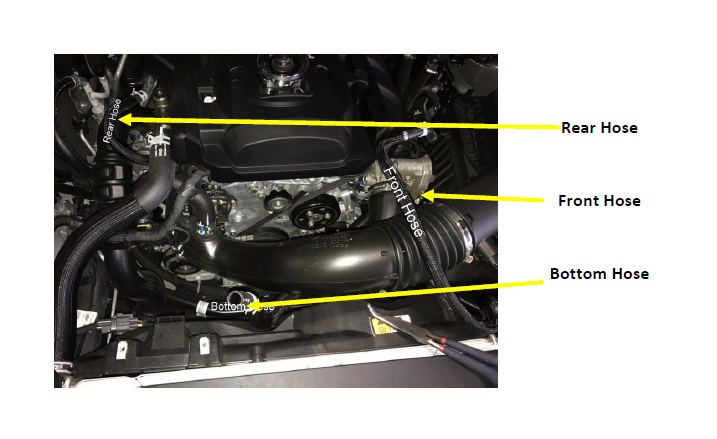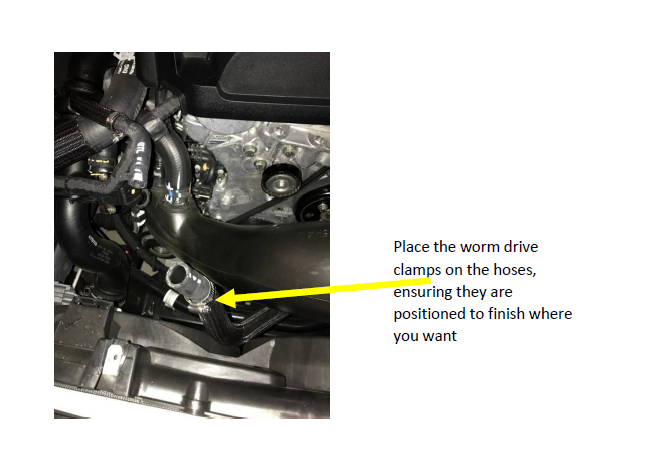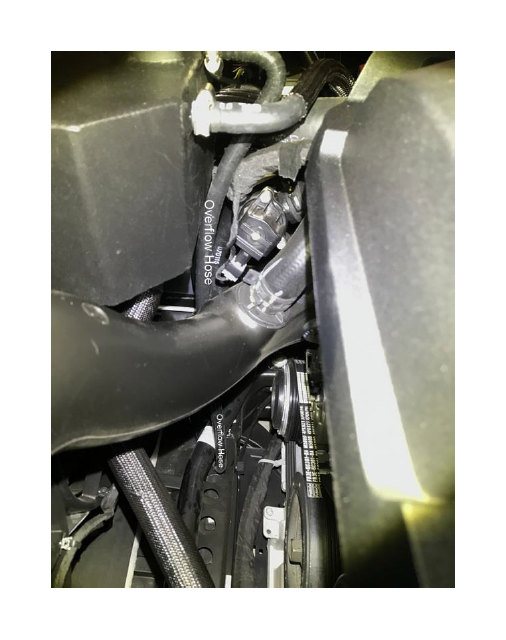
How to Install Mishimoto Aluminum Coolant Expansion Tank - Black on your Mustang
Installation Time
1 hours
Tools Required
- Flashlight
- 10mm ¼” drive deep socket or socket and extension
- ¼” drive ratchet (for bolts, and hose clamps in place of flathead screwdriver)
- Standard flathead screwdriver (for hose clamps, not shown)
- Expansion tank kit
- Hydraulic floor jack and jack stands, or lift
- 7mm socket (for hose clamps and bottom cover)
- 5mm socket (to remove bottom cover)
- Handheld ratchet (plenty of torque for all needs)
- Funnel
- Hose and container for siphon
- Angled needle nose pliers

Shop Parts in this Guide
Note: Mishimoto has an installation video (here) that explains it in 3 minutes. While the video provides a decent overview, the specifics of the install have some options that are available with some explanation.
As you can see, I purchased the tank and promptly fPlasti-Dipped it to get a more matte finish.

1. Preparation:
1. Chock the vehicle if using jack and jack stands
2. Check to make sure all of the parts are accounted for
a. One silicone hose (overflow drain)
b. Four screw drive clamps
c. Expansion Tank
2. Remove coolant:
1. Option 1: Siphon. My vehicle had only about 3000 miles on the coolant, and I felt it was appropriate to remove and reuse the coolant from the top.
a. Remove the cap from the coolant tank
b. Using a clean, empty gallon water bottle and small hose, siphon the expansion tank completely

2. Option 2: Drain from the bottom.
a. Remove the expansion tank cap
b. After chocking the vehicle and lifting it to the desired height, secure it with jack stands.
c. Using the 7mm socket and ratchet remove the 14-7mm bolts in the front bottom cover then
d. Use the 5mm socket to remove the 2-5mm bolts, and lastly
e. Remove the 6 pop clips and set the cover aside
f. Put a hose on the lower radiator drain petcock and drain the desired amount of fluid into an appropriate container
g. When complete, close the drain, replace the bottom cover with the clips, 7mm and 5mm screws
3. Remove the stock hose clamps:
1. Using the angled pliers, loosen and remove the hose clamps on the top hoses

4. Remove the top hoses and mounting bolts:
1. After removing the clamps, remove the top hoses
a. You may need to break them free with the pliers. If so, use the minimum pressure necessary to avoid tearing the hose. Tuck the hoses out of the way, but avoid moving them lower in the system to avoid spilling
2. Using the 10mm socket and ratchet, remove the two mounting bolts


5. Remove bottom hose:
Note: There will be residual fluid in the tank. I found mine to travel from (vehicle) right to left in the top half of the tank, and left to right in the lower half, allowing it to drain completely. However, at this point making the drain port of the tank much higher will cause excess fluid to leak from the upper rear hose wherever it is resting
1. Now you can maneuver the tank to access the bottom hose and clamp.
2. Prior to removal, move the tank around to get any fluid away from the drain port
3. Work the clamp free and then remove the bottom hose, resting it nearby

6. Mounting the new tank
1. Place the new hose clamps where desired

2. Push the bottom hose on and tighten the clamp using a flat head screwdriver, or 7mm socket and ratchet (better solution)
3. Secure the tank using the 2 new 10mm bolts
4. Push on the front and rear hoses, then tighten the clamps accordingly

7. Connecting and routing the overflow drain hose
1. If you are not connecting an additional overflow tank, then you will need to put the included silicone hose into position
a. Mishimoto directs the installer to simply ensure that it is in the radiator lower drain pan, however it would not be restrained in this installation, and there are better options
2. As shown in the photo below, I chose to route the hose down through the frame, and zip tied it to the stiffener for added stability. This allowed the hose to exit the engine compartment through a hole in the frame, letting any actual overflow leave the engine compartment without soiling the radiator pan

8. Refill and replace your cap
1. Before you call it complete, make sure you refill the tank using your coolant of choice
2. When that’s complete, replace your cap
a. Note that my aftermarket cap modification required me to place the hose clamp further back and out of the way of the larger over-cap



